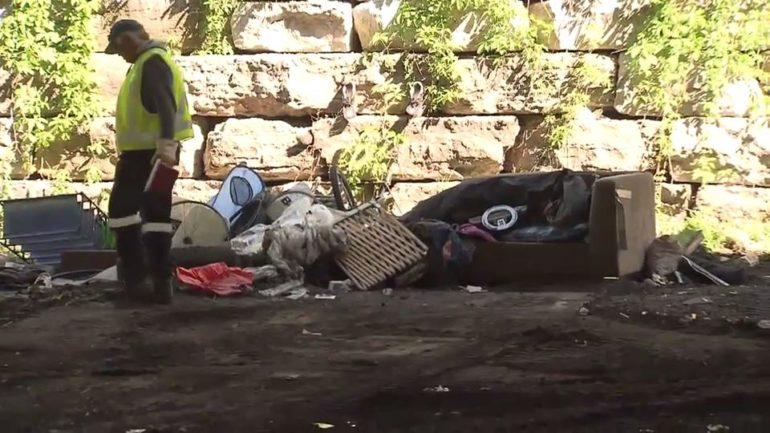
City removes homeless encampment under Gardiner Expressway Friday June 2. (Courtesy: CityNews)
By: Jane Burke
Despite providing aid and advanced warnings for the removal of the homeless community below the Gardiner last week, the encampment is starting to re-establish itself with at least 15 people returning Tuesday night.
The evacuation occurred on Friday June 2 after steps were taken to give the community two weeks notice, but the quick re-population suggests that the cities current solution isn’t working.

Encampments often become community hubs (CBC).
Prior to the evacuation, outreach workers were in the area offering ID clinics, permanent housing solutions and shelter options.
Toronto has been providing more support for the communities before evacuations happen since updated protocol in 2005.
“It’s not a shelter, it’s a community without limited space and I can have my Lucy there,” said Tyler Hammond, 29, who has stayed below the Gardiner in previous years.
Lucy, is Hammond’s dog, who has faithfully stayed by his side at different locations around the city. They now stay with family.
Hammond said Lucy’s loyalty has helped him through challenging days. In return, this means shelters aren’t always an option for them.
“There’s just the one or two shelters that’d take Lucy in with me, and then it’s not always easy to stay, but under the highway it was more permanent and we liked that,” said Hammond.
Beyond just using the highway as a shelter from rain: clothing lines, fires, chairs and coolers are often set up as well, with individuals able to claim specific areas.
City of Toronto shelter support and housing manager, Patricia Anderson doesn’t think the answer for these community members is shelters.
“I had the chance to go and speak to some of the community members staying below the Gardiner two weeks ago, and for many of them said shelters aren’t what they’re looking for,” said Anderson.
City protocol was updated in 2005 to include preliminary outreach work before evacuation of homeless encampments, however, other housing options for this population don’t exist.
“A notice is posted two weeks before anyone goes in, so outreach workers have time to connect with the community and try and help them find alternatives,” said Anderson.
Those who choose to live in encampments may be deliberately avoiding shelters, but with more than 150 encampments removed in Toronto each year, and low bed vacancy rates, shelters likely couldn’t accommodate the 5,000 people who are homeless in Toronto.
“I just can’t afford you know a regular place myself all the time and the shelters just aren’t a good fit for me and Luce,” said Hammond.
Encampments, Anderson said, are typically cleared out after complaints from the community, or because of safety concerns.
In November, homeless advocates protested by sleeping on the sidewalk outside Mayor John Tory’s condominium, after an across-the-board budget freeze affected shelter funding.
The organizers of that protest, the Ontario Coalition Against Poverty cited at the time said that they feel Toronto’s homeless population has been abandoned by the Mayor.

